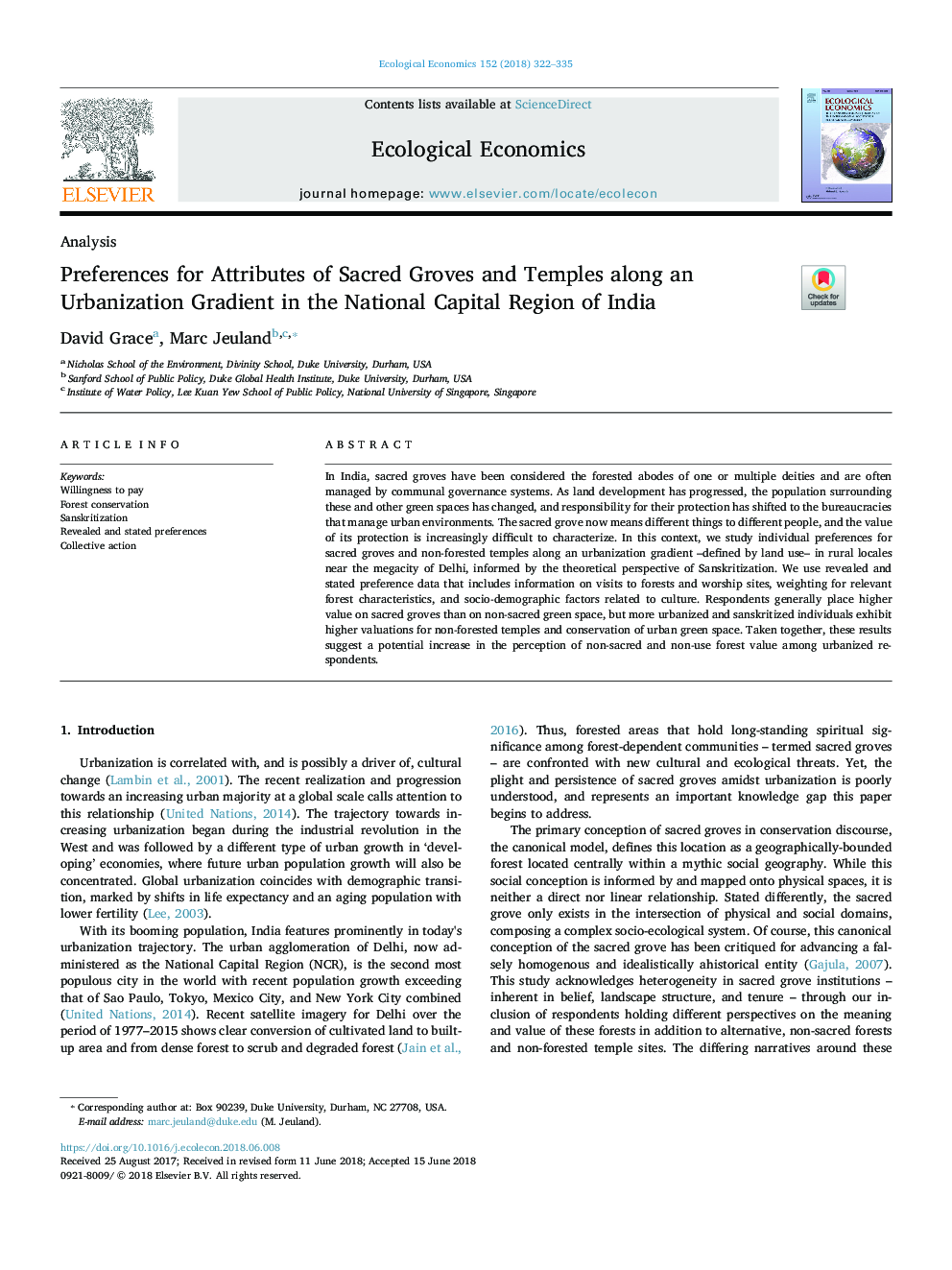| کد مقاله | کد نشریه | سال انتشار | مقاله انگلیسی | نسخه تمام متن |
|---|---|---|---|---|
| 7343845 | 1476327 | 2018 | 14 صفحه PDF | دانلود رایگان |
عنوان انگلیسی مقاله ISI
Preferences for Attributes of Sacred Groves and Temples along an Urbanization Gradient in the National Capital Region of India
ترجمه فارسی عنوان
ترجیحات مربوط به ویژگی های حوضچه های مقدس و معابد در طول گرادیانت شهری در منطقه سرمایه ملی هند
دانلود مقاله + سفارش ترجمه
دانلود مقاله ISI انگلیسی
رایگان برای ایرانیان
کلمات کلیدی
تمایل به پرداخت، حفاظت از جنگل، سانسوریسم، ترجیحات مشخص شده و اظهار داشت، اقدام جمعی،
ترجمه چکیده
در هندوستان، گیاهان مقدس در نظر گرفته شده اند به گونه های جنگلی از یک یا چند خدایان و اغلب توسط سیستم های حکومتی جمعی مدیریت می شود. با پیشرفت زمین توسعه، جمعیت اطراف این و دیگر فضاهای سبز تغییر کرده است و مسئولیت حفاظت آنها به بوروکراتیک هایی است که محیط های شهری را مدیریت می کنند. این گیاه مقدس در حال حاضر به معنای چیزهای مختلف برای افراد مختلف است و ارزش حفاظت آن به طور فزاینده ای دشوار است. در این راستا، ترجیحات فردی برای کاخ های مقدس و معابد غیر موروثی در راستای یک شیوه ی شهرسازی تعریف می شود که از طریق استفاده از آن در مناطق روستایی نزدیک شهری دهلی به چشم می خورد، که با دیدگاه نظری سانسکریته مطرح می شود. ما از داده های ترجیحی آشکار و اظهار شده استفاده می کنیم که حاوی اطلاعات در مورد بازدید از جنگل ها و سایت های عبادت، وزن گذاری برای ویژگی های مربوط به جنگل و عوامل اجتماعی-دموگرافیک مربوط به فرهنگ است. معمولا پاسخ دهندگان ارزش بیشتری در باغ های مقدس نسبت به فضای سبز غیر مقدس دارند، اما افراد شهری و سانسکریته بیشتر ارزیابی های غیر معقول و حفظ فضای سبز شهری را نشان می دهند. با این نتایج، این نتایج نشان می دهد افزایش بالقوه در ادراک ارزش های جنگل غیر مقدس و غیر استفاده در بین پاسخ دهندگان شهری است.
موضوعات مرتبط
علوم زیستی و بیوفناوری
علوم کشاورزی و بیولوژیک
بوم شناسی، تکامل، رفتار و سامانه شناسی
چکیده انگلیسی
In India, sacred groves have been considered the forested abodes of one or multiple deities and are often managed by communal governance systems. As land development has progressed, the population surrounding these and other green spaces has changed, and responsibility for their protection has shifted to the bureaucracies that manage urban environments. The sacred grove now means different things to different people, and the value of its protection is increasingly difficult to characterize. In this context, we study individual preferences for sacred groves and non-forested temples along an urbanization gradient -defined by land use- in rural locales near the megacity of Delhi, informed by the theoretical perspective of Sanskritization. We use revealed and stated preference data that includes information on visits to forests and worship sites, weighting for relevant forest characteristics, and socio-demographic factors related to culture. Respondents generally place higher value on sacred groves than on non-sacred green space, but more urbanized and sanskritized individuals exhibit higher valuations for non-forested temples and conservation of urban green space. Taken together, these results suggest a potential increase in the perception of non-sacred and non-use forest value among urbanized respondents.
ناشر
Database: Elsevier - ScienceDirect (ساینس دایرکت)
Journal: Ecological Economics - Volume 152, October 2018, Pages 322-335
Journal: Ecological Economics - Volume 152, October 2018, Pages 322-335
نویسندگان
David Grace, Marc Jeuland,
